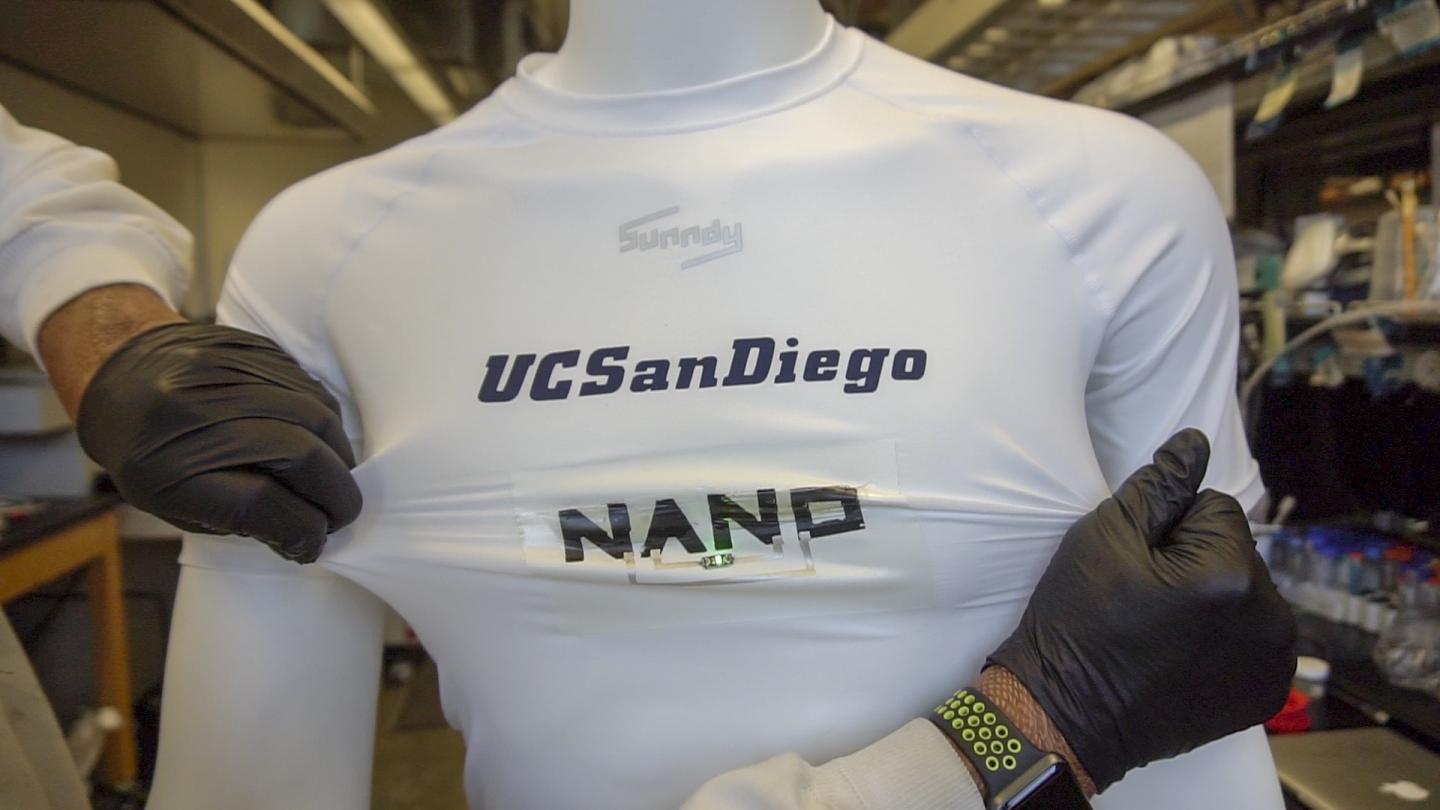
Credit: Jacobs School of Engineering/UC San Diego
Nanoengineers at the University of California San Diego have developed the first printed battery that is flexible, stretchable and rechargeable. The zinc batteries could be used to power everything from wearable sensors to solar cells and other kinds of electronics.
The work appears in the April 19, 2017 issue of Advanced Energy Materials.
The researchers made the printed batteries flexible and stretchable by incorporating a hyper-elastic polymer material made from isoprene, one of the main ingredients in rubber, and polystyrene, a resin-like component. The substance, known as SIS, allows the batteries to stretch to twice their size, in any direction, without suffering damage.
The ink used to print the batteries is made of zinc silver oxide mixed with SIS. While zinc batteries have been in use for a long time, they are typically non-rechargeable. The researchers added bismuth oxide to the batteries to make them rechargeable.
"This is a significant step toward self-powered stretchable electronics," said Joseph Wang, one of the paper's senior authors and a nanoengineering professor at the Jacobs School of Engineering at UC San Diego, where he directs the school's Center for Wearable Sensors. "We expect this technology to pave the way to enhance other forms of energy storage and printable, stretchable electronics, not just for zinc-based batteries but also for Lithium-ion batteries, as well as supercapacitors and photovoltaic cells."
The prototype battery the researchers developed has about 1/5 the capacity of a rechargeable hearing aid battery. But it is 1/10 as thick, cheaper and uses commercially available materials. It takes two of these batteries to power a 3 Volt LED. The researchers are still working to improve the battery's performance. Next steps include expanding the use of the technology to different applications, such as solar and fuel cells; and using the battery to power different kinds of electronic devices.
Researchers used standard screen printing techniques to make the batteries–a method that dramatically drives down the costs of the technology. Typical materials for one battery cost only $0.50. A comparable commercially available rechargeable battery costs $5.00 Batteries can be printed directly on fabric or on materials that allow wearables to adhere to the skin. They also can be printed as a strip, to power a device that needs more energy. They are stable and can be worn for a long period of time.
Making the batteries rechargeable
The key ingredient that makes the batteries rechargeable is a molecule called bismuth oxide which, when mixed into the batteries' zinc electrodes, prolongs the life of devices and allows them to recharge. Adding bismuth oxide to zinc batteries is standard practice in industry to improve performance, but until recently, there hasn't been a thorough scientific explanation for why.
Last year, UC San Diego nanoengineers led by Professor Y. Shirley Meng published a detailed molecular study addressing this question (download PDF here). When zinc batteries discharge, their electrodes react with the liquid electrolyte inside the battery, producing zinc salts that dissolve into a solution. This eventually short circuits the battery. Adding bismuth oxide keeps the electrode from losing zinc to the electrolyte. This ensures that the batteries continue to work and can be recharged.
The work shows that it is possible to use small amounts of additives, such as bismuth oxide, to change the properties of materials. "Understanding the scientific mechanism to do this will allow us to turn non-rechargeable batteries into rechargeable batteries–not just zinc batteries but also for other electro-chemistries, such as Lithium-oxygen," said Meng, who directs the Sustainable Power and Energy Center at the UC San Diego Jacobs School of Engineering
From Innovation to Market
Rajan Kumar, a co-first author on this Advanced Energy Materials paper, is a nanoengineering Ph.D. student at the Jacobs School of Engineering. He and nanoengineering professor Wang are leading a team focused on commercializing aspects of this work. The team is one of five to be selected to join a new technology accelerator at UC San Diego. The technology accelerator is run by the UC San Diego Institute for the Global Entrepreneur, which is a collaboration between the Jacobs School of Engineering and Rady School of Management.
Kumar is excited at the prospect of taking advantage of all that the IGE Technology Accelerator has to offer.
"For us, it's strategically perfect," said Kumar, referring to the $50,000 funding for prototype improvements, the focus on prototype testing with a strategic partner, and the entrepreneurship mentoring.
Kumar is confident in the team's innovations, which includes the ability to replace coin batteries with thin, stretchable batteries. Making the right strategic moves now is critical for commercialization success.
"It's now about making sure our energies are focused in the right direction," said Kumar.
In addition to the IGE Technology Accelerator, the team was also recently selected to participate in the NSF Innovation-Corps (I-Corps) program at UC San Diego, also administered by the Institute for the Global Entrepreneur. One of the key tenets of the I-Corps program is helping startup teams validate their target markets and business models early in the commercialization process. Through NSF I-Corps, for example, Kumar has already started interviewing potential customers which has helped the team better focus their commercialization strategy.
Through these programs, Kumar is focused on leading the team through a series of milestones in order to best position their innovations to refine "both what to build and who to build it for," he said.
###
Paper Citation:
"All-Printed, Stretchable Zn-Ag?O Rechargeable Battery via Hyperelastic Binder for Self-Powering Wearable Electronics" in the journal Advanced Energy Materials.
http://onlinelibrary.wiley.com/doi/10.1002/aenm.201602096/full
Authors: Rajan Kumar, Jaewook Shin, Lu Yin, Jung-Min You, Prof. Shirley Meng and Prof. Joseph Wang, Department of Nanoengineering, Jacobs School of Engineering, University of California San Diego.
Joseph Wang is a distinguished professor, holds the SAIC endowed chair, and serves as chair of the Department of NanoEngineering at the UC San Diego Jacobs School of Engineering where he directs the Center for Wearable Sensors.
Shirley Meng is a professor in the Department of NanoEngineering and Director of the Sustainable Power and Energy Center at the UC San Diego Jacobs School of Engineering.
Research funders include: Advanced Research Projects Agency-Energy (DE-AR0000535); Rajan Kumar acknowledges the U.S. National Science Foundation (NSF) Graduate Research Fellowship under Grant No. (DGE-1144086).
This work was performed in part at the San Diego Nanotechnology Infrastructure (SDNI), a member of the National Nanotechnology Coordinated Infrastructure, which is supported by the U.S. National Science Foundation (NSF).
Media Contact
Ioana Patringenaru
[email protected]
858-822-0899
@UCSanDiego
http://www.ucsd.edu
############
Story Source: Materials provided by Scienmag





